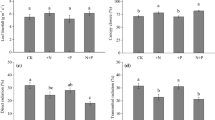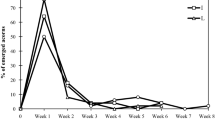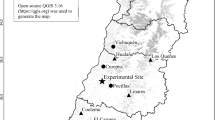Abstract
The size of seeds and the microsite of seed dispersal may affect the early establishment of seedlings through different physiological processes. Here, we examined the effects of seed size and light availability on seedling growth and survival, and whether such effects were mediated by water use efficiency. Acorns of Quercus petraea and the more drought-tolerant Quercus pyrenaica were sowed within and around a tree canopy gap in a sub-Mediterranean forest stand. We monitored seedling emergence and measured predawn leaf water potential (Ψpd), leaf nitrogen per unit area (Na), leaf mass per area, leaf carbon isotope composition (δ13C) and plant growth at the end of the first summer. Survival was measured on the next year. Path analysis revealed a consistent pattern in both species of higher δ13C as Ψpd decreased and higher δ13C as seedlings emerged later in the season, indicating an increase in 13C as the growing season is shorter and drier. There was a direct positive effect of seed size on δ13C in Q. petraea that was absent in Q. pyrenaica. Leaf δ13C had no effect on growth but the probability of surviving until the second year was higher for those seedlings of Q. pyrenaica that had lower δ13C on the first year. In conclusion, leaf δ13C is affected by seed size, seedling emergence time and the availability of light and water, however, leaf δ13C is irrelevant for first year growth, which is directly dependent on the amount of seed reserves.





Similar content being viewed by others
References
Aranda I, Pardos M, Puértolas J, Jiménez MD, Pardos JA (2007) Water-use efficiency in cork oak (Quercus suber) is modified by the interaction of water and light availabilities. Tree Physiol 27:671–677
Arbuckle JL (2003) AMOS 5 user’s guide. Smallwaters Corportation, Chigago, IL
Asbjornsen H, Vogt KA, Ashton MS (2004) Synergistic responses of oak, pine and shrub seedlings to edge environments and drought in a fragmented tropical highland oak forest, Oaxaca, Mexico. For Ecol Manag 192:313–334
Augspurger CK, Cheeseman JM, Salk CF (2005) Light gains and physiological capacity of understorey woody plants during phenological avoidance of canopy shade. Funct Ecol 19:537–546
Baayen RH, Davidson DJ, Bates DM (2008) Mixed-effects modeling with crossed random effects for subjects and items. J Mem Lang 59:390–412
Baraloto C, Forget P-M, Goldberg DE (2005) Seed mass, seedling size and neotropical tree seedling establishment. J Ecol 93:1156–1166
Bates DM (2005) Fitting linear mixed models in R. R News 5:27–30
Bentler PM (1989) EQS structural equations program manual. BMDP Statistical software, Los Angeles
Bonfil C (1998) The effects of seed size, cotyledon reserves, and herbivory on seedling survival and growth in Quercus rugosa and Q. laurina (Fagaceaea). Am J Bot 85:79–87
Brookes PC, Wigston DL, Bourne WF (1980) The dependence of Quercus robur and Quercus petraea seedlings on cotyledon potassium, magnesium, calcium, and phosphorus during the first year of growth. Forestry 53:167–177
Casper BB, Forseth IN, Wait DA (2005) Variation in carbon isotope discrimination in relation to plant performance in a natural population of Cryptantha flava. Oecologia 145:541–548
Castro J (2006) Short delay in timing of emergence determines establishment success in Pinus sylvestris across microhabitats. Ann Bot 98:1233–1240
Castro J, Reich PB, Sánchez-Miranda A, Guerrero JD (2008) Evidence that the negative relationship between seed mass and relative growth rate is not physiological but linked to species identity: a within-family analysis of Scots pine. Tree Physiol 28:1077–1082
Cordell S, Goldstein G, Meinzer FC, Handley LL (1999) Allocation of nitrogen and carbon in leaves of Metrosideros polymorpha regulates carboxylation capacity and δ13C along an altitudinal gradient. Funct Ecol 13:811–818
Damesin C, Lelarge C (2003) Carbon isotope composition of current-year shoots from Fagus sylvatica in relation to growth, respiration and use of reserves. Plant Cell Environ 26:207–219
Damesin C, Rambal S, Joffre R (1998) Seasonal and annual changes in leaf δ13C in two co-occurring Mediterranean oaks: relations to leaf growth and drought progression. Funct Ecol 12:778–785
Du Y, Huang Z (2008) Effects of seed mass and emergence time on seedling performance in Castanopsis chinenesis. For Ecol Manag 255:2495–2501
Duan B, Li C, Zhang X, Korpelainen H (2009) Water deficit affects mesophyll limitation of leaves more strongly in sun than in shade in two contrasting Picea asperata populations. Tree Physiol 29:1551–1561
Dudley SA (1996) Differing selection on plant physiological traits in response to environmental water availability: a test of adaptive hypotheses. Evolution 50:92–102
Eglin T, Fresneau C, Lelarge-Trouverie C, Francois C, Damesin C (2009) Leaf and twig δ13C during growth in relation to biochemical composition and respired CO2. Tree Physiol 29:777–788
Ehleringer JR (1993) Variation in leaf carbon isotope discrimination in Encelia farinosa: implications for growth, competition, and drought survival. Oecologia 95:340–346
Ehleringer JR, Cooper TA (1988) Correlations between carbon isotope ratio and microhabitat in desert plants. Oecologia 76:562–566
Farquhar GD, O’Leary MH, Berry JA (1982) On the relationship between carbon isotope discrimination and the intercellular carbon dioxide concentration in leaves. Aust J Plant Physiol 9:121–137
Farquhar GD, Ehleringer JR, Hubick KT (1989) Carbon isotope discrimination and photosynthesis. Annu Rev Plant Physiol Plant Mol Biol 40:503–537
Flexas J, Medrano H (2002) Drought-inhibition of photosynthesis in C3 plants: stomatal and non-stomatal limitations revisited. Ann Bot 89:183–189
Geber MA, Griffen LR (2003) Inheritance and natural selection on functional traits. Int J Plant Sci 164(3 Suppl):S21–S42
Gómez-Aparicio L, Pérez-Ramos IM, Mendoza I, Matías L, Quero JL, Castro J, Zamora R, Marañón T (2008) Oak seedling survival and growth along resource gradients in Mediterranean forests: implications for regeneration in current and future scenarios. Oikos 117:1683–1699
Imaji A, Seiwa K (2010) Carbon allocation to defense, storage, and growth in seedlings of two temperate broad-leaved tree species. Oecologia 162:273–281
Jones RH, Allen BP, Sharitz RR (1997) Why do early-emerging tree seedlings have survival advantages?: a test using Acer rubrum (Aceraceae). Am J Bot 84:1714–1718
Kennedy PG, Hausmann NJ, Wenk EH, Dawson TE (2004) The importance of seed reserves for seedling performance: an integrated approach using morphological, physiological, and stable isotope techniques. Oecologia 141:547–554
Khurana E, Singh JS (2004) Response of five dry tropical tree seedlings to elevated CO2: impacts of seed size and successional status. New For 27:139–157
Long TJ, Jones RH (1996) Seedling growth strategies and seed size effects in fourteen oak species native to different soil moisture habitats. Trees 11:1–8
McDowell N, Pockman WT, Allen CD, Breshears DD, Cobb N, Kolb T, Plaut J, Sperry J, West A, Williams DG, Yepez EA (2008) Mechanisms of plant survival and mortality during drought: why do some plants survive while others succumb to drought? New Phytol 178:719–739
Mediavilla S, Escudero A (2003) Mature trees versus seedlings: differences in leaf traits and gas exchange patterns in three co-occurring Mediterranean oaks. Ann For Sci 60:455–460
Meziane D, Shipley B (2001) Direct and indirect relationships between specific leaf area, leaf nitrogen and leaf gas exchange. Effects of irradiance and nutrient supply. Ann Bot 88:915–927
Milla R, Escudero A, Iriondo JM (2009) Inherited variability in multiple traits determines fitness in populations of an annual legume from contrasting latitudinal origins. Ann Bot 103:1279–1289
Nanos N, Pardo F, Nager JA, Pardos JA, Gil L (2005) Using multivariate factorial kriging for multiscale ordination: a case study. Can J For Res 35:2860–2874
Nicotra AB, Davidson A (2010) Adaptive phenotypic plasticity and plant water use. Funct Plant Biol 37:117–127
Picotte JL, Rosenthal DM, Rhode JM, Cruzan MB (2007) Plastic responses to temporal variation in moisture availability: consequences for water use efficiency and plant performance. Oecologia 153:821–832
Ponton S, Dupouey J-L, Bréda N, Dreyer E (2002) Comparison of water-use efficiency of seedlings from two sympatric oak species: genotype × environment interactions. Tree Physiol 22:413–422
Quero JL, Villar R, Marañón T, Zamora R, Poorter L (2007) Seed-mass effects in four Mediterranean Quercus species (Fagaceae) growing in contrasting light environments. Am J Bot 94:1795–1803
Ramel F, Sulmon C, Gouesbet G, Couée J (2009) Natural variation reveals relationships between pre-stress carbohydrate nutritional status and subsequent response to xenobiotic and oxidative stress in Arabidopsis thaliana. Ann Bot 104:1323–1337
Rich PM (1990) Characterising plant canopies with hemispherical photographs. Remote Sens Rev 5:13–29
Rodríguez-Calcerrada J, Pardos JA, Gil L, Reich PB, Aranda I (2008) Light response in seedlings of a temperate (Quercus petraea) and a sub-Mediterranean species (Quercus pyrenaica): contrasting ecological strategies as potential keys to regeneration performance in mixed marginal populations. Plant Ecol 195:273–285
Rodríguez-Calcerrada J, Cano FJ, Valbuena-Carabaña M, Gil L, Aranda I (2010) Functional performance of oak seedlings naturally regenerated across microhabitats of distinct overstorey canopy closure. New For 39:245–259
Sandquist DR, Ehleringer JR (2003) Carbon isotope discrimination differences within and between contrasting populations of Encelia farinose raised under common-environment conditions. Oecologia 134:463–470
Seiwa K (1998) Advantages of early germination for growth and survival of seedlings of Acer mono under different overstorey phenologies in deciduous broad-leaved forests. J Ecol 86:219–228
Seiwa K (2000) Effects of seed size and emergence time on tree seedling establishment: importance of developmental constraints. Oecologia 123:208–215
Shipley B (2000) Cause and correlation in biology—a user’s guide to path analysis, structural equations and causal inference. Cambridge University Press, UK
R Development Core Team (2009) R: a language and environment for statistical computing. R Foundation for statistical computing, Vienna, Austria. http://www.r-project.org
Tripathi RS, Khan ML (1990) Effects of weight and microsite characteristics on germination and seedling fitness in two species of Quercus in a subtropical wet hill forest. Oikos 57:289–296
Urbieta IR, Pérez-Ramos IM, Zavala MA, Marañón T, Kobe RK (2008) Soil water content and emergence time control seedling establishment in three co-occurring Mediterranean oak species. Can J For Res 38:2382–2393
Verdú M, Traveset A (2005) Early emergence enhances plant fitness: a phylogenetically controlled meta-analysis. Ecology 86:1385–1394
Villar-Salvador P, Heredia N, Millard P (2010) Remobilization of acorn nitrogen for seedling growth in holm oak (Quercus ilex), cultivated with contrasting nutrient availability. Tree Physiol 30:257–263
Acknowledgments
We thank Guillermo González Gordaliza and Jesús Alonso for their helpful assistance in the field and Matthew T. Robson and Javier Cano for helping measuring and sowing the acorns. We are also grateful to Ruben Milla for advice on path analysis and critical reading of the manuscript, and Nicolas Fanin for constructive comments on data analysis. This work was supported by funding from projects CCG07-UPM/AMB-1865 and SUM2008-00004-C03-01.
Conflict of interest
None.
Author information
Authors and Affiliations
Corresponding author
Additional information
Communicated by T. Koike.
Electronic supplementary material
Below is the link to the electronic supplementary material.
Rights and permissions
About this article
Cite this article
Rodríguez-Calcerrada, J., Nanos, N. & Aranda, I. The relevance of seed size in modulating leaf physiology and early plant performance in two tree species. Trees 25, 873–884 (2011). https://doi.org/10.1007/s00468-011-0562-x
Received:
Revised:
Accepted:
Published:
Issue Date:
DOI: https://doi.org/10.1007/s00468-011-0562-x




